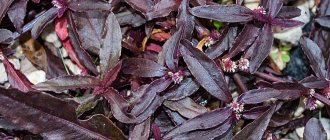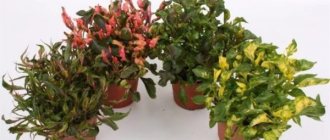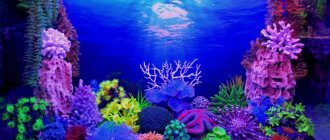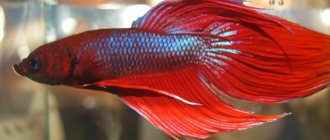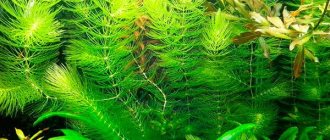Alternanthera in the aquarium
Alternanthera is a charming plant that immediately attracts attention. This is a red, blazing fire in the underwater kingdom.
The plant looks great in a variety of aquascapes; as a rule, this plant is used as a focal point. Some Alternanthera species are successfully used in aquariums and ponds: Alternanthera sessilis and Alternanthera reineckii.
Alternanteras were brought to Europe by South American importers in the late seventies. Around the same time, they appeared among our amateur aquarists. The genus Alternanthera Forskal, 1775 belongs to the Amaranthaceae family. There are approximately 200 species in the genus. These are annual and perennial herbaceous plants, bushes and even trees. They are common in tropical and subtropical regions of America, Asia, Australia, Africa, and are even found on the Galapagos Islands.
All representatives of the genus have counter or opposite leaves. The flowers are usually inconspicuous and not conspicuous, but the color of the leaves is so magnificent that several species are widely used in floriculture. Alternanteras, low-growing compact plants used in gardens and parks when decorating carpet flower beds, flower beds, borders, etc. They can be given any shape, as they tolerate cutting quite well. Alternanthera vesikolor looks great, its leaves and stems are dark or copper red, turning to pink; Between the veins on the leaves there are greenish and copper spots. Alternanthera amoena (Lem) Voss and A. bettzickiana are excellent decorations for interiors, their blood-red spots contrast beautifully with the greenery of other plants. Some Alternanthera species are successfully cultivated in aquariums. They were brought to our country under the commercial names “Telantera osiris”, “T. lilacina", "T. rubra". All these plants grow, bloom and reproduce well in water. Upon more detailed study by botanists, it was found that these alternanthera should be classified as follows:
Alternanthera reineckii Briquet, 1899 (“Telantera osiris”);
Alternanthera sessilis (L. 1753) De Candolle, 1813, having two varieties: A. sessilis var. lilacina (“Telantera lilacina”) and A. sessilis var. rubra ("Telantera rubra").
Description of the plant
Alternanthera reineckii is an aquatic plant. Distributed throughout South America, Australia, Africa and Asia, and even the Galapagos. Alternanters became popular in Europe and Russia by the end of the seventies of the last century.
This plant is from the amaranth family, numbering two hundred varieties of annual and perennial shrubs, trees and herbs.
Alternanthera grows on the shores of water bodies in Africa, Australia, America and Europe
Prefers river, lake and swampy areas of tropical areas. Under natural conditions, the height of the alternanthera is 40 cm or more.
Compact kelp bushes resemble flaming fires, only underwater. Because of this feature, it is used for aquascaping. Even inexperienced aqua designers will appreciate the ease of care and breeding.
What is the difference between Reineki Mini and Alternanthera?
Alternanthera rhineca mini, bred in artificial conditions, belongs to the decorative species. On average it reaches 12-18 cm in height. However, for decorative purposes it is used to create a “carpet” effect, the height of which does not exceed 5-10 cm.
A peculiarity of this species is the change in color of the leaves from red to green in low light conditions.
The dwarf variety has a poorly developed root system, so it is recommended to plant the bushes in groups of 3-9 pieces. This will reduce the risk of soil erosion and plant death.
Name variations
The species is presented under several alternative names:
- alternanthera rhineca;
- rozanervig;
- marble;
- alternanthera red round;
- cardinal;
- alternanthera rosaefolia;
- red ruby;
- aquarium
Alternanthera received all these names due to the fact that the leaves growing upward reveal the lower part in red shades.
There are more than 200 species of alternanthera in nature.
Appearance
Alternanthera rosanervig is a harmonious and original plant, reflecting its external characteristics as belonging to the equatorial zone: a blazing fire on a green background. On the front side, the leaves have a color from light green and olive to dark green, while on the back they are painted in a palette of red shades: from light pink to scarlet and burgundy.
Alternanthera looks like a red flaming fire in the underwater kingdom
Lilac alternanthera has equally pink-red leaves on both sides. The saturation of the color depends greatly on the brightness of the lighting.
Reineka also blooms in summer with white, pink or green-yellow flowers located in the axils of the leaves. But they are so small and unsightly that compared to the bright foliage they are difficult to notice. Therefore, the plant is valuable not for its flowers, but for its nature-colored leaves.
Rhineka grows all year round, but does not grow much. Alternanthera bushes in captivity can grow up to 25 cm in height. On a large and dense trunk, narrow, triangular, large or curly leaves, up to 5 cm long, 1-3 cm wide, are located in pairs perpendicularly due to the variety of varieties. Its long lashes occupy a significant area of the water surface .
Alternanthera blooms with small, inconspicuous flowers throughout the year.
Thread-like roots grow both in the lower part of the plant and next to the foliage, ensuring the best absorption of essential nutrients and microelements from the water.
Alternanthera tends to develop both under water and above the water surface. At the same time, it grows surface leaf plates, but it sheds underwater ones.
Alternanthera sesilis
The process of adaptation to water conditions is not hampered by the falling of the lower leaves, since new ornamental bushes are formed. With sufficient lighting in the aquarium, the upper side of the leaf is usually green, the lower side is light green or pinkish; in partial shade or shaded areas - olive-brown and violet-red, respectively. But, unfortunately, this plant has a less intense red color than other Alternanthera species cultivated in our country. It grows equally well in shaded areas and in direct light. Sufficiently mature, well-formed parts of the stems that have at least four pairs of leaves should be planted in the aquarium. This is the only species of the genus that reproduces quite quickly under water, forming powerful bushes. Groups of 10–15 plants look most attractive. They are good for decorating the back walls of small aquariums. In large species aquariums, groups of alternanthers are placed in the middle part in free places, where they form islands with an area of 20–30 square centimeters. Alternatera sessile is characterized by the fact that in its terrestrial form it has a dense, highly branched stem, and in conditions of low humidity it is creeping. The seeds are small, whitish.
Alternanthera sessilis var. lilacina is found in warm areas around the globe. This plant adapts well to different forms of existence and can grow both underwater and on land. The color of plants is very variable and depends on cultivation conditions. Usually the upper side of the leaf is olive green, the lower side is dark red to purple. But sometimes forms appear in which the leaves on both sides are colored intense red. In the middle zone, the plant can be successfully cultivated in open ground in summer. To keep it in an aquarium, this alternanthera must be grown in conditions of high air humidity (85–95 percent) in a tropical paludarium at a temperature of 20 to 30 ° C. Young, not yet flowering shoots, when planted under water, easily take root and relatively rarely die. The plant is insensitive to the chemical composition of water, tolerates both partial shade and excess light equally well, the optimal pH value of water is about 7. The basic rule when growing this alternanthera is to create fairly stable conditions in the aquarium. It grows well in crystal clear water without algae. Alternanthera sessilis var. rubra is an emergent plant and can be easily cultivated in a moist paludarium. It grows very quickly: in 3–4 weeks the stem reaches a length of 15–20 centimeters with a large number of leaves. The underwater form forms branched creeping stems above the ground, and only a third of them straighten and also begin to branch strongly near the surface of the water. In general, they reach a length of 50–60 centimeters. The leaves are opposite, 3.5–5.0 centimeters long and 0.8–1.7 centimeters wide. On both sides they are painted ruby red. The stem is also red.
Pressed to the ground with a pebble, it forms a large number of white roots in the place of an independent pair of leaves and takes root easily. The flowers are completely sessile, red or pink; they appear in the axils of the opposite pair of leaves. Since this plant comes from the tropics, it begins to bloom around the equinox, when there is 12 hours of light per day, that is, the length of a tropical day. These plants are usually planted in an aquarium in groups of 3–5 or more shoots. The most suitable place is in the middle part of the pond, where they are placed in front of taller green and yellow-green plants. Under water, they take root within ten days, but subsequently they do not grow as quickly as in a paludarium, and retain their decorative appearance well for 2–6 months. When the leaves begin to fall, the plants should be replaced with new ones. To do this, you need to have an additional greenhouse, growing new adult plants from cuttings in it, which need the highest possible air humidity and diffused lighting. In aquarium conditions A. sessilis var. rubra needs good light and slightly acidic water.
Alternanteras are amazingly beautiful plants that serve as decoration for decorative aquariums. They also look great when cultivated in open reservoirs of garden plots, where you can create compositions with both aquatic forms and those that have emerged to the surface of the water and rooted on coastal soil.
The benefits and harms of the plant
There is no harm from Reineka to any of the aquarium inhabitants or the environment.
But the benefits are significant:
- saturates water with oxygen,
- acts as a natural biofilter,
- provides shelter for many aquarium inhabitants.
The decorative properties of the plant are also indisputable.
Alternanthera saturates the water with oxygen and also serves as a refuge for many species of fish.
Where to put
— The lighting is quite bright and diffused. The richness of the color of the leaves depends on the lighting. Since Alternanthera prefers average growing conditions, it is better to observe the light regime.
— Temperature – varies in summer from 18 to 28 degrees, but in winter the temperature is not lower than 14 degrees. In the summer, this flower can be taken out onto street verandas or terraces.
— Humidity can be maintained by periodic spraying, although Alternanthera tolerates dry air.
Maintenance and care in the aquarium
To properly maintain Alternanthera rhineca in an aquarium environment, it is necessary to create and maintain conditions very similar to natural ones.
The optimal solution for planting plants would be shelves on the sides of the container. The tops of the reineka should be located close to the surface of the water. The slowly growing lashes spread across the water, gradually sinking back from their weight. It is also recommended to plant alternanthera in the center, without thickening brittle bushes.
In the aquarium, the alternanthera is planted in the center
In a shallow aquarium (up to 20-25 cm), algae grow above the water and form airy leaves. Underwater leaves are shed. To avoid this, it is necessary to pinch the top of the stem in time. This simple procedure will help the plant keep its leaves under water and the stem actively branch.
Composition and required amount of soil
Alternanthera rhineca is unpretentious in terms of soil composition. Its special root system is adapted to obtain food from water, but nevertheless, in coarse river sand, the roots develop more efficiently. It is recommended to use a special ready-made mixture.
It is better to crush weak roots with large pebbles or bury them deeper. Otherwise, fish may dig up the plant. Large individuals bite off the tops of the algae, but this is not scary, and is even useful for the branching of the alternanthera.
The plant is not picky about the thickness of the soil layer. Even in a 2-centimeter layer it grows and develops well.
For normal development of the root system, the minimum soil thickness should be at least 2-3 cm
Top dressing
Mineral nutrition plays an important role for algae growth. The plant needs nitrogenous substances and microelements. It is very convenient to use liquid fertilizers. It is necessary to choose complexes with a low nitrogen content - from its excess the leaves turn yellow.
Once every 2 weeks it is necessary to add divalent iron salts (iron sulfate) approximately 0.2 mg per 1 liter of water.
Feeding Alternanthera begins in February and ends at the end of August.
To improve the process of photosynthesis, you can saturate the water in the aquarium with carbon dioxide.
When adding various fertilizers to the water, it should be taken into account that they can be harmful for some aquarium inhabitants.
Saturation of water with carbon dioxide will improve the growth process of aquarium plants
Optimal lighting
As a plant of the equatorial strip, alternanthera requires bright lighting, because the color of the leaves depends on it. Natural light has the most beneficial effect. The length of daylight hours should be 12 hours.
Daylight can be replaced with artificial light from fluorescent lamps. To prevent burns to the surface shoots of the plant, it is necessary to use lighting with a power of 3 W per 1 dm2 of water surface area.
With excessive lighting, the bushes die due to an intensive increase in the number of green algae.
To illuminate the alternant, it is recommended to use special fluorescent lamps
Water parameters
The water in an aquarium with alternanthera should be fresh with neutral hardness, pH 6.2-7 and a temperature of 23-28 degrees (in winter up to 17-20 degrees). Be sure to change 20% of the water once a week.
It is necessary to ensure regular filtration of aquarium water.
Frequency of pruning
To maintain the aesthetic appearance of Alternanthera rhineca and maintain its health, it is necessary to prune as the shoots grow. Pinch the top of the stem when it approaches the water's edge, which happens about once a month.
The top part of the plant should be pinched regularly.
Wintering
Perennial varieties require special care in winter. An important maintenance condition is good lighting. If there is a lack of sunlight, the crop should be placed under artificial lamps.
The temperature for keeping alternanthera in winter should be no more than 18 degrees. The optimal temperature is 14 degrees.
In winter, the crop stops growing and does not require much water. Therefore, when grown indoors, watering is reduced to 2 times a week.
Methods of propagation and planting
In an aquarium or greenhouse, Alternanthera can be easily propagated by cuttings. The stem is divided into several parts with 4-5 nodes with leaves. Throw them on the surface of the water. Within a week, the roots grow, then it’s time to plant them in the ground.
It is not necessary to plant the plant, as it can grow and develop in free floating conditions.
In greenhouse conditions, in the fall, cut cuttings can be immediately placed in the ground. The pot along with the cutting is wrapped in cling film and placed under artificial lighting. When the first shoots with leaves appear on the cuttings, they should be buried and watered, and the film should be removed. After the rhineka begins to grow, the top must be pinched to allow the side shoots to grow. The plant spends the winter in a pot, and before the beginning of summer it should be transplanted into open ground.
In winter, it is recommended to plant alternanthera in a flower pot.
To form a lush bush, you can plant several seedlings in one hole at once.
In alternanthera, which grows underwater, the flowers may not fade for a long time. Once pollinated, the petals fold and form black seeds underneath. After the flowers die, they fall to the ground, but very rarely germinate.
Propagation by seeds is considered an ineffective method.
Features of reproduction
- The plant reproduces vegetatively. To form a new bush, you should divide the strong stem into cuttings containing 5 whorls with leaves and place them in water.
- After 1 week, roots form in the lower part of the shoots. This means that the “babies” are ready to be transplanted into the ground.
Common diseases and pests
Only Alternanthera, growing in flower pots in the apartment, gets sick. It is often affected by gray rot due to excess moisture and stagnation of water in the pot. It can be treated by treating the plant with a solution of copper sulfate and normalizing watering after removing the affected areas of the plant.
Often a young plant is spoiled by aphids and whiteflies, as well as spider mites. Damaged parts must be cut off and the bush treated with insecticides.
Pests that attack the plant include: aphids, whiteflies and spider mites
How to care
— The soil can be used universally for all indoor plants or you can make it yourself. To do this, you need to take equal parts of turf, leaf, humus soil and sand. In any case, the soil should be loose and light. You can add perlite or vermiculite to it.
— Planting is carried out in a pot or other container of your choice (a regular pot or a hanging one). We place a layer of drainage at the bottom of the pot, then add soil and place the plant in the center. Add soil and water generously.
— Transplantation is carried out in the spring, when the roots completely entwine the earthen ball.
Using plants in landscape design
Alternanteras are widely used in gardens and parks to decorate flower beds and flower beds. These compact bright plants decorate artificial ponds and wet greenhouses, taking advantage of the contrast of juicy red and green.
Alternanthera is used in landscape design
This crop can be given a variety of shapes, as it easily responds to cutting.
Alternanthera lilacina
Alternanthera violet for the aquarium
Under natural conditions, plants are found in reservoirs with low-flow waters, mainly in South America. She only requires clean water and no direct light. Tolerates complete immersion, but still prefers to rise slightly above the water.
Beautiful flowering can be observed only above the surface; in an aquarium, the sprouts reach no more than half a meter in height. It acquires a bright shade only when there is sufficient carbon dioxide content in the water. For this purpose, special periodic feedings are done. The plant has another name: large anther and is very popular in aquarium design.
Useful lifehacks
It is recommended to plant Alternanthera in a pot suspended in the middle of the aquarium so that the plant looks slightly above the water. To avoid drying out the tops, the light should be placed high above the surface of the water.
Other useful tips:
- The microclimate of the alternanthera in a pot can be brought closer to the tropical one by increasing the humidity in the room. Then the plant will delight the owner with flowering.
- It is not recommended to plant bushes very close to each other so that the stems do not rot, and also due to the increased fragility of the plant.
- In dim light, the leaves begin to fall. In order for the lower leaves to receive more light, it is necessary to separate the bare parts of the stem and plant them side by side.
- Shoots grown in air have an extremely painful time getting used to the aquarium environment.
To prevent stem rotting, plants are placed away from each other.
This unusual plant can be either indoor or greenhouse, or aquarium. Decorativeness allows you to achieve amazing results both in landscape design and in aquascaping. And its unpretentiousness in keeping and breeding makes it even more attractive.
Have you seen alternanthera in aquariums or greenhouses? Or maybe you yourself are the owner of this unusual plant? Share your opinion about it in the comments.
Content
- 1 Description
- 2 Water parameters
- 3 Lighting
- 4 Ground
- 5 Feeding
- 6 Reproduction
- Other names: Alternanthera Reineckii, Alternanthera Roseafolia, Alternanthera Pink, Alternanthera pink.
- Origin: South America.
- Size: height up to 50 cm.
- Temperature: 18-28 °C.
- Water parameters: pH 5-8.
- Lighting: 0.75 W/l.
- Growth rate: average.
- Additional information: plant for aquariums, palundariums, looks best in the background and center.
- Difficulty of maintenance: complex, requires the addition of CO2, Fe.

